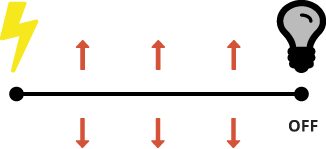SAFETY AND ADVISORY
Learn about electricity safety tips to better protect yourself.
Electrical & Magnetic Fields
Know more about the EMF and how it affects us.
Electric and magnetic fields (EMF) are present everywhere in our environment but are invisible to the human eye. Earth is a natural source of EMF; lightning is a product of electric field build-up during thunderstorms, while compass needles are oriented by earth’s magnetic field. Electricity, microwaves and radiofrequency fields are man-made sources of EMFs that form a major part of our modern life. Power frequency (50Hz in Malaysia) EMF is associated with electrical apparatus including power lines, underground cables and home appliances.
Created by voltage – the higher the voltage, the stronger the magnetic field.
Can be found near any electrical appliance that is plugged in, even if it is not operating.
Strongest when it is closest to their source.
Electric fields
Produced by voltage.

Lamp plugged in but turned off.
Voltage produces an electric field.
Measured in volts per meter (V/m) or in kilovolts per meter (kV/m).
Easily shielded (weakened) by conducting objects such as trees and buildings.
Strength decreases rapidly with increasing distance from the source.
Created by current or electricity flowing through a wire.
Strength increases with current, so a stronger magnetic field can be found near an appliance when it runs on “high” than when it runs on “low”.
Strongest when it is close to their source.
Magnetic fields
Produce by current.

Lamp plugged in but turned on.
Current now produces a magnetic field also.
Measured in gauss (G) or tesla (T).
Not easily shielded (weakened) by most material.
Strength decreases rapidly with increasing distance from the source.
| Electric fields | Magnetic fields |
|
Created by voltage – the higher the voltage, the stronger the magnetic field. Can be found near any electrical appliance that is plugged in, even if it is not operating. Strongest when it is closest to their souce. |
Created by current or electricity flowing through a wire. Strength increases with current, so a stronger magnetic field can be found near an appliance when it runs on “high” than when it runs on “low”. Strongest when it is close to their source. |
|
Electric fields Produced by voltage. 
Lamp plugged in but turned off.
Measured in volts per meter (V/m) or in kilovolts per meter (kV/m). Easily shielded (weakened) by conducting objects such as trees and buildings. Strength decreases rapidly with increasing distance from the source. |
Magnetic fields Produced by current. 
Lamp plugged in but turned on.
Measured in gauss (G) or tesla (T). Not easily shielded (weakened) by most material. Strength decreases rapidly with increasing distance from the source. |
How exposed are we?
We are constantly exposed to the magnetic field at home, office or in an industrial environment because of our close contact with appliances and machinery. Since these machines draw a large amount of current when they operate, they produce some level of magnetic field.
Studies and researches have shown no firm evidence of a link between EMF from power lines or other power supply installations and any acute or long-term effect on human health.
Steps you can take to reduce EMF emissions
We take all necessary measures to reduce EMF emissions such as:
- Ensure the design and configuration of power lines and substations minimise EMF emissions.
- Provide extra precautionary measures by maintaining wider clearance than statutory requirement.
- Comply with EMF regulations, guidelines or best practices recognised by international bodies.
- Prohibit development directly beneath TNB lines, and within their right-of-way to ensure safety clearances.
- Review and update scientific findings on EMF across the world, and continue to reassess the situation.
Produced by voltage (pressure which forces electricity along wires).
Measured in volts per meter (V/m) or in kilovolts per meter (kV/m).
Easily shielded (weakened by conducting objects such as trees and building.
Strength decreases rapidly with increasing distance from the source.
Produced by current flow (when the apparatus is switched on).
Measured in gauss (G) or Tesla (T).
Not easily shielded (weakened) by most material.
Strength decreases rapidly with increasing distance from the source.






